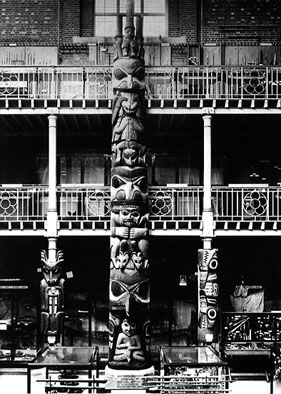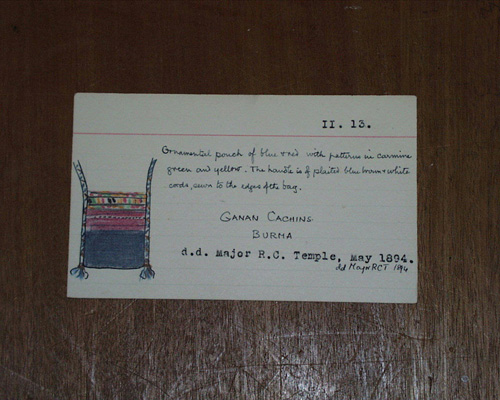
Important Members of Staff of the Pitt Rivers Museum, Since 1884
Tylor
Balfour
Thomas
Penniman
Fagg
Cranstone
Jones
Blackwood
History of the Pitt Rivers Museum
Tylor
Tylor contributed generously to the collections. It is to him
that the Museum owes its most spectacular single exhibit - the
forty-foot-high totem pole which once stood in front of a Haida
... house in the village of Masset, Queen Charlotte Islands, British
Columbia, and now dominates the Court of the Pitt Rivers Museum.

Its arrival, in 1901, must have been quite an outstanding event. The raven's six-foot-long beak had to be detached for shipment, but was skilfully replaced in the Museum. The enormous planks in which the pole was encased for its journey remained on the Museum premises until 1940, when the technicians transformed them into much needed storage cupboards, timber being then unobtainable. In recognition of a distinguished career, the University later conferred upon Tylor the title of Professor. Since there was no chair in Ethnology, this title was honorary and did not descend to his successor. He continued to lecture until 1909, when he retired ... He was knighted in 1912 and died in 1917 (Blackwood, 1970:10-11).
There is an amusing story about Tylor -
'I [Professor Sir J.L. Myers] ... attended his [Tylor] lectures in the Mathematical Room in the University Museum. The audience was small, mostly ladies. ... Mrs Tylor sat in the front row, watchful for confusion among the specimens. 'Oh Edward dear' she would say, 'last time, you said that one was neolithic'. But she did not prevent the conflagration when he demonstrated the fire drill, and his long beard became entangled with the bow. Usually he got no fire.'
(Anthropology at Oxford: 6)
Balfour
During Balfour's forty-eight years as Curator, the collections
steadily increased in size and range, in no small degree as a
result of his own journeys to many then almost unknown parts of
the world. ... Characteristic of him was a story he told [Blackwood]
during a lecture on bows and arrows, to the effect that on one
occasion when he was working alone in the Museum, he pricked himself
with a poisoned arrow. It was Sunday, and no one was within reach.
He sat down with a pencil and paper ready to describe his symptoms
until the end. After about an hour, during which no symptoms appeared,
he realised that there was not to be an end, and concluded that
the passage of time had deprived the poison of its virulence.
He finished the story with a warning ... to take no chances with
poisoned arrows, or we might not be so lucky... Towards the end
of his Curatorship, Balfour, like Tylor, was awarded the honorary
title of Professor, which like Tylor's, did not descend to his
successor. ... (Blackwood, 1970: 11)
... after the death of the Museum's first curator in 1939, ... his son, ... generously gave [the Museum] his father's very extensive private collection as well as his library ... (Blackwood, 1970: 15)
In 1973 the Museum received a bequest from Balfour's son of over £100,000 for unspecified museum use. The money was spent on building new Music and hunter and gatherer galleries on Banbury Road, because of environmental difficulties the new building did not open until 1986.
Thomas
Ernest Seymour Thomas was employed by Henry Balfour as Assistant
Curator from the early 1920s. Prior to his appointment in Oxford
Thomas had been preparing a catalogue of the ethnographical collections
of the Royal Geographical Society of Egypt in Cairo, the catalogue
was published in 1924. His knowledge of ethnography combined with
his cataloguing and drawing skills were to stand him in good stead
in the Pitt Rivers Museum where his two major monuments are the
manuscript catalogues of General Pitt Rivers' collection and the
hand-written card catalogues of the Naga collections. Both of
these valuable research tools are illustrated with Thomas's meticulous
sketches of objects. Apart from these tasks, Thomas also assisted
Balfour with day-to-day curatorial duties, particularly labelling
and listing of specimens. He died in 1936, while still working
at the Museum.
(Paraphrased from a longer account of Thomas's life and work in the Friends of the Pitt Rivers Museum Newsletter October 1995 no. 14 by Linda Mowat).

A catalogue card bearing a drawing of a Kachin bag from Burma, done by Thomas.
Penniman
'Henry Balfour died in February 1939, and was succeeded by T.K.
Penniman, who had been Acting Curator during Balfour's last illness.
One of the major decisions the new Curator was called upon to
make was whether, in view of the possibility of bombing raids,
the contents of the Museum should be evacuated to some 'safe'
place in a remote part of the country. After much anxious thought,
in the face of well-meant advice, he decided to keep the collections
in the Museum, weighing against the possibility of loss by enemy
action, the certainty of damage and deterioration by moth, rust,
woodworm, and all the other pests to which a collection such as
ours in vulnerable if not regularly and frequently inspected.
.... The laborious work of copying in duplicate on 5" x 3" index
cards the entries in the Accession Books (until then the only
record of what the Museum possessed), was done by Penniman and
his colleagues during the dark days of the Second World War. ...(Blackwood,
1970: 13)
Fagg
Penniman retired at the end of 1963 ... [and] the Museum's third
... Curator, B.E.B. Fagg, took office on 1 January 1964 [and served
as Director until his retirement in 1975]. He had previously been
the Director of Antiquities at Jos, Nigeria ... One of his first
projects was the construction, at the west end of the Museum Court,
of an enclosed gallery to be used for special exhibitions, ...
these special exhibitions can be changed from time to time without
interrupting the normal use of the Museum... He greatly increased
the amount of storage accommodation available ...' (Blackwood,
1971:13).
Cranstone
In 1976 B.A.L. Cranstone was appointed as the fourth curator of
the Museum, he came to Oxford with some thirty years of curatorial
experience in the Ethnography Department of the British Museum.
During his curation a store for reserve collections was created
in an inner suburb of Oxford. He retired in 1985.
Jones
In 1985, Schuyler Jones was appointed the fifth Curator to the
Museum. During his tenure the title was changed to Director and
the Assistant Curator/ Lecturers titles were changed to Curator/
Lecturers. During the twelve years the size of the Museum's staff
and number of buildings increased dramatically.
Blackwood
Beatrice Blackwood, whose first University appointment was as
a Research Assistant and later Demonstrator in the Department
of Human Anatomy (1918 - 1927),was appointed University Demonstrator
in Ethnology in 1927 and University Lecturer in 1936. She retired
in 1959 and came into the Museum the next morning as if nothing
had happened, continuing to work full time for a further sixteen
years. By a curious coincidence her period of active service to
the Museum exactly equalled Henry Balfour's forty-eight years.
(Jones, 1991: 13)